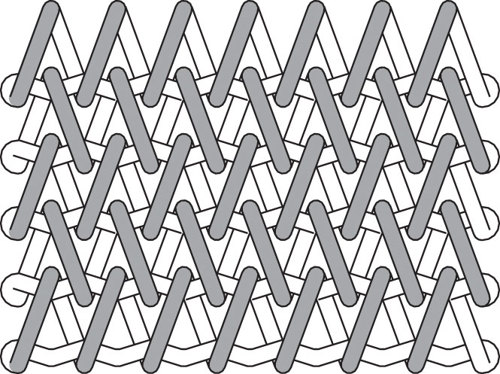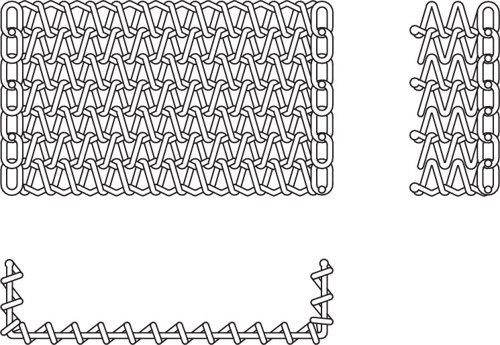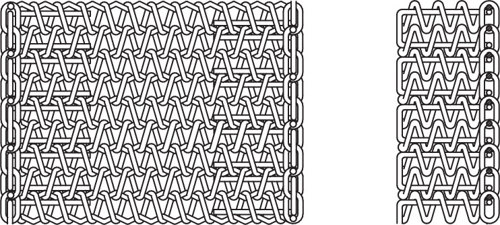

Ashworth's Woven Wire Belts are great for food processing or industrial applications.
Balanced Weave Conveyor Belts
Ashworth Straight Running Friction Driven Belts are woven wire belts that are drum, as opposed to sprocket, driven. Within this product grouping are a host of woven wire belts, ranging from the simplest, conventional weave designs, to the most complex, tightly-woven compound balance weave belts. Some of our most popular belts are individually featured below. However, construction possibilities for straight running, friction driven belts are practically endless, considering the number of different materials and weave patterns are available. Contact an Ashworth associate for assistance in selecting a straight running friction driven belt that is specifically tailored for your application.
NOTE: Our woven belts are measured for length under tension.
Balanced Weave Conveyor Belts
Specifications
Options
Downloads
Specifications
Technical Specifications
| Technical Specifications | Unit | |
|---|---|---|
| Material | Stainless, carbon, and galvanized steels, high temperature alloys | |
| Maximum Width | in. (mm) | 216.00 (5486.4) |
| Weight | Dependent on mesh count and wire gauge | |
| Allowable Tension | Dependent on mesh count and wire gauge | |
| Conveying Surface | Full belt width | |
| Opening Size (Based on mesh count) | Maximum recommended opening is 75% of minimum product size | |
| Method of Drive | Friction driven on flat-faced drums or terminal rolls; minimum drum diameter is 180 divided by the second count/CB number, if applicable | |
| Maximum Temperature | °F (°C) | Carbon steel: 1000(538) Stainless steel: 2050 (1121) Inconel® 601: 2200 (1204) |
Available Options
Balanced Weave belts are composed of right and left-handed spirals joined by a single crimped connector per spiral row. Edges of the belt are welded. Mesh choice is nearly unlimited and is dependent upon requirements of the application, including product weight and support requirements, as well as process temperature. These belts are less dense than Compound Balanced weave belts.
| Lateral Pitch of Mesh | Minimum Belt Width in. (mm) |
|---|---|
| 12 | 3.00 (76.2) |
| 18 | 2.00 (50.8) |
| 24 | 1.50 (38.1) |
| 30 | 1.20 (30.5) |
| 36 | 1.00 (25.4) |
| 42 | 0.88 (22.4) |
| 48 | 0.75 (19.1) |
| 60 | 0.60 (15.2) |
| 66 | 0.55 (14.0) |
| 72 | 0.50 (12.7) |
| 84 | 0.43 (10.9) |
| 96 | 0.38 (9.7) |
| 102 | 0.35 (8.9) |
| 144 | 0.25 (6.4) |
Belt Calculator
No Results
Base Belt Weight
Working Strength
Opening Size
Open Area Surface
Open Area Thru
Estimated Thickness
Min Drum Diameter
Need more detailed information?
Need more detailed information?
Need more detailed information?
Options
Product Options
Mesh Designation
Balanced Weave belts are composed of right- and left-hand spirals joined by a single crimped connector per spiral row. Edges of the belt are welded. Mesh choice is nearly unlimited and is dependent upon requirements of the application, including product weight and support requirements, as well as process temperature. These belts are less dense than Compound Balanced weave belts.

Guard Edges
Guard edges can be fabricated for balanced weave belts via two primary methods; relieved and turned-up fabric or relieved and reinforced turned-up fabric.
Relieved & Turned-Up
With relieved and turned-up fabric, the guard edge is formed by turning
up the belt edges from the carrying surface and omitting connectors at prescribed spacing to provide flexibility.

Relieved & Reinforced Turned-Up
Guard edges produced via relieved and reinforced turned-up fabric methodology are similar to relieved and turned-up edge, but with the addition of hairpin reinforcements that are inserted into the disconnected spirals.

Controls
Ashworth recommends use of Ashworth Model #1 or Model #2 Control Systems to prevent the belt from contacting oven framework and to keep the belt centered on the terminal drums. See pages 180-181 for more information on Ashworth Control Systems.
Does this meet your project needs?
Does this meet your project needs?
Does this meet your project needs?
Let’s get started!
Let’s get started!
Let’s get started!
Downloads
Downloads
Technical Bulletins
Illustrations
-
Balanced Weave, B6-6-6
-
Balanced Weave, B12-10-8
-
Balanced Weave, B18-17-10
-
Balanced Weave, B18-12-12
-
Balanced Weave, B24-16-12
-
Balanced Weave, B24-18-14
-
Balanced Weave, B24-21-1417
-
Balanced Weave, B24-21-16
-
Balanced Weave, B24-22-12
-
Balanced Weave, B24-24-12
-
Balanced Weave, B24-24-1214
-
Balanced Weave, B24-24-14
-
Balanced Weave, B24-25-1012
-
Balanced Weave, B30-18-1112
-
Balanced Weave, B30-24-16
-
Balanced Weave, B30-24-17
-
Balanced Weave, B30-28-18
-
Balanced Weave, B30-29-16
-
Balanced Weave, B30-30-14
-
Balanced Weave, B30-30-16
-
Balanced Weave, B30-30-18
-
Balanced Weave, B36-15-1214
-
Balanced Weave, B36-20-1012
-
Balanced Weave, B36-24-1214
-
Balanced Weave, B36-24-14
-
Balanced Weave, B36-24-1416
-
Balanced Weave, B36-24-1618
-
Balanced Weave, B36-28-10
-
Balanced Weave, B36-30-1214
-
Balanced Weave, B36-30-16
-
Balanced Weave, B36-32-1416
-
Balanced Weave, B36-32-16
-
Balanced Weave, B36-36-14
-
Balanced Weave, B36-36-16
-
Balanced Weave, B36-36-18
-
Balanced Weave, B36-30-18
-
Balanced Weave, B42-18-1012
-
Balanced Weave, B42-27-14
-
Balanced Weave, B42-27-16
-
Balanced Weave, B42-30-1012
-
Balanced Weave, B42-36-18
-
Balanced Weave, B42-36-16
-
Balanced Weave, B42-36-17
-
Balanced Weave, B42-38-16
-
Balanced Weave, B42-40-16
-
Balanced Weave, B42-41-14
-
Balanced Weave, B48-24-16
-
Balanced Weave, B48-26-1214
-
Balanced Weave, B48-28-1012
-
Balanced Weave, B48-36-16
-
Balanced Weave, B48-37-15
-
Balanced Weave, B48-38-15
-
Balanced Weave, B48-48-16
-
Balanced Weave, B48-48-17
-
Balanced Weave, B48-48-18
-
Balanced Weave, B48-49-18
-
Balanced Weave, B48-52-18
-
Balanced Weave, B60-24-14
-
Balanced Weave, B60-36-14
-
Balanced Weave, B60-36-16
-
Balanced Weave, B60-38-1214
-
Balanced Weave, B60-38-14
-
Balanced Weave, B60-38-16
-
Balanced Weave, B60-48-14
-
Balanced Weave, B60-48-1820
-
Balanced Weave, B60-48-20
-
Balanced Weave, B60-55-16
-
Balanced Weave, B60-60-16
-
Balanced Weave, B60-38-1416
-
Balanced Weave, B60-48-18
-
Balanced Weave, B60-48-16
-
Balanced Weave, B60-60-12
-
Balanced Weave, B60-60-18
-
Balanced Weave, B66-48-1718
-
Balanced Weave, B72-24-16
-
Balanced Weave, B72-36-16
-
Balanced Weave, B72-60-16
-
Balanced Weave, B72-62-16
-
Balanced Weave, B72-66-18
-
Balanced Weave, B72-68-16
-
Balanced Weave, B72-68-18
-
Balanced Weave, B72-68-1820
-
Balanced Weave, B72-72-18
-
Balanced Weave, B72-72-20
-
Balanced Weave, B72-75-18
-
Balanced Weave, B84-76-16
-
Balanced Weave, B84-84-17
-
Balanced Weave, B84-84-18
-
Balanced Weave, B96-84-20
-
B018 012 1214
-
B006 006 0606
-
B012 010 0808
-
B012 010 1012
-
B018 012 1212
-
B018 016 1010
-
B018 016 1212
-
B018 016 1414
-
B018 017 1010
-
B024 016 1212
-
B024 018 1414
-
B024 021 1417
-
B024 021 1616
-
B024 022 1212
-
B024 024 1212
-
B024 024 1214
-
B024 024 1414
-
B024 025 1012
-
B030 016 1012F
-
B030 018 1112
-
B030 024 1616
-
B030 024 1717
-
B030 028 1818
-
B030 029 1616
-
B030 030 1414
-
B030 030 1616
-
B030 030 1818
-
B036 015 1114F
-
B036 015 1214
-
B036 018 1012F
-
B036 020 0810
-
B036 020 1012
-
B036 020 1012F
-
B036 020 1212
-
B036 020 1212F
-
B036 020 1214F
-
B036 020 1414
-
B036 024 1214
-
B036 024 1414
-
B036 024 1416
-
B036 024 1616
-
B036 024 1618
-
B036 024 1818
-
B036 030 1214
-
B036 030 1616
-
B036 030 1818
-
B036 032 1416
-
B036 032 1616
-
B036 036 1414
-
B036 036 1818
-
B036 038 1616
-
B042 018 1012
-
B042 018 1616
-
B042 024 1616
-
B042 027 1414
-
B042 027 1616
-
B042 030 1012
-
B042 032 1418
-
B042 036 1616
-
B042 036 1717
-
B042 036 1818
-
B042 038 1616
-
B042 040 1616
-
B042 041 1414
-
B048 017 1416F
-
B048 022 1717
-
B048 024 1616
-
B048 026 1212
-
B048 026 1214
-
B048 026 1414F
-
B048 028 1012
-
B048 032 1214
-
B048 032 1414
-
B048 036 1416
-
B048 036 1616
-
B048 037 1515
-
B048 038 1515
-
B048 048 1414
-
B048 048 1414F
-
B048 048 1616
-
B048 048 1717
-
B048 048 1818
-
B048 049 1818
-
B048 052 1818
-
B048 055 1616
-
B060 016 1414
-
B060 016 1414F
-
B060 024 1414
-
B060 035 1616
-
B060 036 1414
-
B060 036 1616
-
B060 037 1114
-
B060 038 1214
-
B060 038 1414
-
B060 038 1416
-
B060 038 1616
-
B060 048 1414
-
B060 048 1616
-
B060 048 1718F
-
B060 048 1818
-
B060 048 1820
-
B060 048 2020
-
B060 055 1616
-
B060 060 1414
-
B060 060 1616
-
B060 060 1618F
-
B060 060 1818
-
B060 060 2020
-
B066 048 1718
-
B066 048 1718F
-
B072 012 1516
-
B072 020 1416F
-
B072 024 1616
-
B072 032 1616
-
B072 036 1616
-
B072 044 1818
-
B072 048 1616
-
B072 048 2020
-
B072 056 1616
-
B072 060 1616
-
B072 062 1416
-
B072 062 1616
-
B072 066 1818
-
B072 068 1616
-
B072 068 1818
-
B072 068 1820
-
B072 072 1818
-
B072 072 2020
-
B072 075 1818
-
B084 020 1616
-
B084 056 1818
-
B084 060 1818
-
B084 072 1820
-
B084 076 1618
-
B084 084 1717
-
B084 084 1818
-
B084 084 2020
-
B096 024 1717
-
B096 024 1818
-
B096 036 1818
-
B096 048 1818
-
B096 084 2020
-
B144 096 2022
-
U066 048 1718
-
U066 048 1718F
-
CB2 060 060 1618F
-
CB3 036 076 1416
-
CB3 036 076 1416F
-
CB3 042 042 1416F
-
CB3 048 108 1818F
-
CB3 060 096 1818
Conveyor System Review Form



